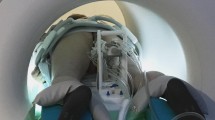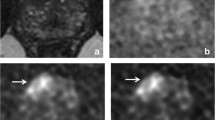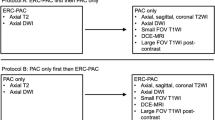Abstract
Thirty-seven consecutive patients with elevated PSA levels and negative tumor prostate biopsies underwent a MR-guided prostate biopsy in a 1.5-T scanner in the supine position. After localization of suspected tumor areas using an endorectal coil and two body-phased array coils, the biopsy device was positioned without any repositioning of the patient. The biopsy device consisted of a mount, a ball joint, a positioning stage and an insertion stage with a needle guide, which was filled with a MR-visible fluid to control positioning of the needle using a balanced steady-state free precession sequence (TrueFISP) and a high-resolution turbo spin echo (T2-TSE) sequence. Core biopsies were taken manually in the magnet. The biopsy needle could be correctly positioned in all cases. Suspected lesions with a diameter ≥10 mm could be successfully punctured. Four to nine (mean =6) biopsies were taken per patient. In 14 patients, prostate cancer was confirmed at histology. Twenty-four biopsies positive for cancer were performed in 14 patients. A correct correlation was found between the site of biopsy and histology. MR-guided prostate biopsy can be effective in increasing primary positive tumor biopsy results in patients with a history of negative tumor TRUS-guided prostate biopsies.


Similar content being viewed by others
References
Dennis LK, Resnick MI (2000) Analysis of recent trends in prostate cancer incidence and mortality. Prostate 42:247–252
Beyersdorff D, Winkel A, Hamm B, Lenk S, Loening StA, Taupitz M (2005) MR imaging-guided prostate biopsy with a closed MR unit at 1.5 T: Initial results. Radiology 234:576–581
Wefer AE, Hricak H, Vigneron DB, Coakley FV, Lu Y, Wefer U, Mueller-Lisse U et al (2000) Sextant localization of prostate cancer: comparison of sextant biopsy magnetic Resonance imaging and magnetized resonance spectroscopic imaging with step section histology. J Urol 164:400–404
Ikonen S, Kärkkäinen P, Kivisaari L, Salo JO, Taari K, Vehmas T, Tervahartiala P et al (1998) Magnetic resonance imaging of clinically localized prostate cancer. J Urol 159:915–919
Beyersdorff D, Taupitz M, Winkelmann B, Fischer Th, Lenk S, Loening StA, Hamm B (2002) Patients with a history of elevated prostate-specific antigen levels and negative transrectal US-guided quadrant or sextant biopsy results: value of MR imaging. Radiology 224:701–706
D’Amico AV, Schnall M, Whittington R, Malkowicz SB, Schultz D, Tomaszewski JE, Wein A (1998) Endorectal coil magnetic resonance imaging identifies locally advanced prostate cancer in select patients with clinically localized disease. Urology 51:449–454
Vilanova JC, Comet J, Capdevila A, Barcelo J, Dolz JLI, Huguet M, Barcelo C et al (2001) The value of endorectal MR imaging to predict positive biopsies in clinically intermediate-risk prostate cancer patients. Eur Radiol 11:229–235
Cruz M, Tsuda K, Narumi Y, Kuroiwa Y, Nose T, Kojima Y et al (2002) Characterization of low-intensity lesions in the peripheral zone of prostate on pre-biopsy endorectal coil MR imaging. Eur Radiol 12:357–365
Perrotti M, Han KR, Epstein RE, Kennedy EC, Rabbani F, Badani K (1999) Prospective evaluation of endorectal magnetic resonance imaging to detect tumor foci in men with prior negative prostatic biopsy: a pilot study. J Urol 162:1314–1317
Comet-Batlla J, Vilanova-Busquets JC, Saladie-Roig JM, Gelabert-Mas A, Barcelo-Vidal C (2003) The value of endorectal MRI in the early diagnosis of prostate cancer. Eur Urol 44:201–208
Engelhard K, Hollenbach HP, Deimling M, Kreckel M, Riedl C (2000) Combination of signal intensity measurements of lesions in the peripheral zone of prostate with MRI and serum PSA level for differentiating benign disease from prostate cancer. Eur Radiol 10:1947–1953
Kiessling F, Lichy M, Grobholz R, Heilmann M, Farhan N, Michel MS, Trojan L et al (2004) Simple models improve the discrimination of prostate cancers from the peripheral gland by T1-weighted dynamic MRI. Eur Radiol 14:1793–1801
Cooksen MS et al (2000) Update on transrectal ultrasound-guided needle biopsy of the prostate. Mol Urol 4:93–97
Uzzo RG, Wie JT, Waldbaum RS, Perlmutter AP, Byrne JC, Vaughan ED (1995) The influence of prostate size on cancer detection. J Urol 152:2304–2307
Keetch DW, Catalona WJ, Smith DS (1995) Serial prostatic biopsies in men with persistently elevated serum prostate specific antigen values. J Urol 6:1571–1574
Kimberly A, Roehl JO, Ann V, Catalona A, Catalona WJ (2002) Serial biopsy results In prostate cancer screening study. J Urol 167:2435–2439
Rørvik J, Haukaas S (2001) Magnetic resonance imaging of the prostate. Curr Opin Urol 11:181–188
Quint LE, Van Erp JS, Bland PH, Del Buono EA, Mandell StH, Grossman HB, Gikas PW (1991) Prostate cancer: correlation of MR images with tissue optical density at pathologic examination. Radiology 179:837–842
Hata N, Jinzaki M, Kacher D, Cormak R, Gering D, Nabavi A, Silverman StG et al (2001) MR imaging-guided prostate biopsy with surgical navigation software: device validation and feasibility. Radiology 220:263–268
Cormack RA, D’Amico AV, Hata N, Silverman S, Weinstein M, Tempany CM (2000) Feasibility of transperineal prostate biopsy under interventional magnetic resonance Guidance. Urology 56:663–664
D’Amico AV, Tempany CM, Cormack R, Hata N, Jinzaki M, Tuncali K, Weinstein M et al. (2000) Transperineal magnetic resonance image guided prostate biopsy. J Urol 104:385–387
Susil RC, Camphausen K, Choyke P, Elliot R, McVeigh ER, Gustafson GS, Ning H et al (2004) System for prostate brachytherapy and biopsy in a standard 1.5-T MRI scanner. Magn Reson Med 52:683–687
Zangos ST, Eichler K, Engelmann K, Ahmed M, Dettmer S, Herzog C, Pegios W et al (2005) MR-guided transgluteal biopsies with an open low-field system in patients with clinically suspected prostate cancer: technique and preliminary results. Eur Radiol 15:174–182
Lopez-Corona E, Ohori M, Scardino PT, Reuter VE, Gonen M, Kattan MW (2003) A Nomogram for predicting a positive repeat prostate biopsy in patients with a previous negative biopsy session. J Urol 170:1184–1188
Author information
Authors and Affiliations
Corresponding author
Rights and permissions
About this article
Cite this article
Engelhard, K., Hollenbach, H.P., Kiefer, B. et al. Prostate biopsy in the supine position in a standard 1.5-T scanner under real time MR-imaging control using a MR-compatible endorectal biopsy device. Eur Radiol 16, 1237–1243 (2006). https://doi.org/10.1007/s00330-005-0100-6
Received:
Revised:
Accepted:
Published:
Issue Date:
DOI: https://doi.org/10.1007/s00330-005-0100-6




